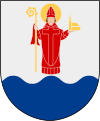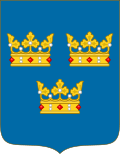Växjö
| Växjö, Sweden | ||
|---|---|---|
| ||
 Växjö, Sweden  Växjö, Sweden | ||
| Coordinates: 56°52′37″N 14°48′33″E / 56.87694°N 14.80917°ECoordinates: 56°52′37″N 14°48′33″E / 56.87694°N 14.80917°E | ||
| Country | Sweden | |
| Province | Småland | |
| County | Kronoberg County | |
| Municipality | Växjö Municipality | |
| Area[1] | ||
| • City | 30.28 km2 (11.69 sq mi) | |
| Elevation | 167 m (548 ft) | |
| Population (31 December 2015)[1] | ||
| • City | 65,345 | |
| • Density | 2,011/km2 (5,210/sq mi) | |
| • Metro | 88,108 | |
| Time zone | CET (UTC+1) | |
| • Summer (DST) | CEST (UTC+2) | |
| Postal code | 35x xx | |
| Area code(s) | (+46) 47 | |
| Website |
www | |
Växjö ([²vɛkːɧøː]) is a city and the seat of Växjö Municipality, Kronoberg County, Sweden. It had 63,479 inhabitants as of 2013,[1] out of a municipal population of 85,000. It is the administrative, cultural and industrial centre of Kronoberg County and the episcopal see of the Diocese of Växjö. The town is home to Linnaeus University.
Etymology
The city's name is believed to be constructed from the words "väg" (road) and "sjö" (lake), meaning the road over the frozen Växjö Lake that farmers took in the winter to get to the marketplace that later became the city.
History
In contrast to what was believed a century ago,[2] there is no evidence of a special pre-Christian significance of the site. The pagan cultic center of Värend may have been located at Hov, a nearby village.[3][4]
The city has been an Episcopal see since the 12th century, but did not get its city charter until 1342, issued by Magnus Eriksson. During the Middle Ages Växjö did not have many pious institutions. A Franciscan monastery was established in 1485. There was a hospital of the Holy Ghost, first mentioned in 1318. In the 14th century Växjö got its first school, Växjö katedralskola. In 1643 it received gymnasium status.
At the beginning of Gustav Eriksson's war of liberation, the peasantry joined forces under the guidance of the union-hostile bishop Ingemar Pedersson, the mountain men and the peasantry of Dalarna, Hälsingland and Gästrikland, who urged fidelity to their leader Gustav Eriksson.
During the Dacke War, a peasant uprising, the city was under the authority of Nils Dacke and his supporters, especially David Santander, from the summer of 1542 until after New Year 1543.
Several times during the Northern Wars, Scanian Wars and thereafter, the city was affected by fire (in 1277, 1516, 1570, 1612, 1658, 1690, 1749, 1753, 1799, 1838 and 1843). After the last fire in 1843, when 1,140 citizens were rendered homeless, Växjö received its current street plan.[5]
The Barbarella nightclub was prominent in southeastern Sweden in the 1970s, attracting a number of major international bands.
Demography
|
Source:[6]
Environmental policy
In 1996 the city adopted a policy of eliminating the use of fossil fuels by 2030.[7][8] This decision was taken in reaction to pollution and eutrophication in the lakes that surround the town. Greenhouse gas emissions were cut by 41% from 1993 to 2011, and have been reduced by 55% by 2015. The city's economy has grown during this time.[9]
By 2014, Växjö's CO2 emissions had dropped to 2.4 tonnes per capita, well below the EU average of 7.3 tonnes.[10]
Notable locations
The city has three municipality-run secondary schools ("gymnasiums"); Teknikum, Katedralskolan, Växjö and Kungsmadskolan. The Linnaeus University campus had 42,000 students as of 2012.[11]
Industries include Alstom and Aerotech Telub, as well as Volvo Articulated Haulers located in Braås 29 kilometres (18 miles) north of Växjö. One of the most well-known service providers is Visma. Växjö houses Sweden's National Glass Museum [12] and claims to be the capital of the "Kingdom of Crystal" [13] as well as of the "Kingdom of Furniture".[14]
The Swedish Emigrant Institute [15] was established in 1965 and resides in the House of Emigrants near the Växjö lake in the heart of the city. It contains archives, library, museum, and a research center relating to the emigration period between 1846 and 1930, when 1.3 million (or 20%) of the Swedish population emigrated, mainly to the United States. Archives, dating to the 17th century, of birth and death records as well as household records are available on microfiche.
Immediately north of Växjö is Kronoberg Castle, a ruined fortress constructed in the 15th century. This castle was used as a base by the rebel Nils Dacke during the Dacke War. The fortress has thick walls and artillery portals that face north towards lake Helgasjön. Teleborg Castle is also located near the city. It was built near the Linnaeus University in the year 1900 as a morning (wedding) gift. The Teleborg Castle now functions as a hotel and conference facility.
Climate
Växjö has an oceanic climate.[16] It is milder, wetter and cloudier than most of Sweden, with sunshine hours being more associated with the British Isles than with areas further north in the country. Considering its relative distance to all three coasts surrounding South Sweden, the climate is extremely marine, with winter lows being relatively subdued for an inland location. Temperatures have risen in recent years and for the 1961-1990 reference period Växjö was almost humid continental; however, under the standard Köppen classification it is well within the oceanic range for the 2002-2015 period. When compared with sunnier areas inland further north, Växjo has relatively cool summers.
| Climate data for Växjö | |||||||||||||
|---|---|---|---|---|---|---|---|---|---|---|---|---|---|
| Month | Jan | Feb | Mar | Apr | May | Jun | Jul | Aug | Sep | Oct | Nov | Dec | Year |
| Record high °C (°F) | 9.6 (49.3) |
13.8 (56.8) |
20.0 (68) |
27.9 (82.2) |
29.0 (84.2) |
32.5 (90.5) |
32.9 (91.2) |
34.4 (93.9) |
27.6 (81.7) |
21.9 (71.4) |
14.0 (57.2) |
11.3 (52.3) |
34.4 (93.9) |
| Average high °C (°F) | 0.4 (32.7) |
1.0 (33.8) |
5.5 (41.9) |
12.0 (53.6) |
16.4 (61.5) |
19.6 (67.3) |
22.2 (72) |
21.0 (69.8) |
16.8 (62.2) |
10.3 (50.5) |
5.6 (42.1) |
2.0 (35.6) |
11.0 (51.8) |
| Daily mean °C (°F) | −1.6 (29.1) |
−1.4 (29.5) |
1.6 (34.9) |
6.7 (44.1) |
11.2 (52.2) |
14.4 (57.9) |
17.3 (63.1) |
16.4 (61.5) |
12.6 (54.7) |
7.2 (45) |
3.5 (38.3) |
0.0 (32) |
7.3 (45.1) |
| Average low °C (°F) | −3.7 (25.3) |
−3.9 (25) |
−2.3 (27.9) |
1.4 (34.5) |
6.0 (42.8) |
9.2 (48.6) |
12.4 (54.3) |
11.8 (53.2) |
8.4 (47.1) |
4.1 (39.4) |
1.4 (34.5) |
−2.0 (28.4) |
3.5 (38.3) |
| Record low °C (°F) | −34.0 (−29.2) |
−28.8 (−19.8) |
−29.8 (−21.6) |
−19.0 (−2.2) |
−6.0 (21.2) |
−0.8 (30.6) |
3.5 (38.3) |
0.0 (32) |
−4.8 (23.4) |
−10.3 (13.5) |
−17.8 (0) |
−24.5 (−12.1) |
−34.0 (−29.2) |
| Average precipitation mm (inches) | 52.1 (2.051) |
34.9 (1.374) |
41.4 (1.63) |
39.6 (1.559) |
47.6 (1.874) |
54.9 (2.161) |
76.6 (3.016) |
57.4 (2.26) |
71.0 (2.795) |
57.8 (2.276) |
63.4 (2.496) |
55.6 (2.189) |
652.6 (25.693) |
| Mean monthly sunshine hours | 34 | 63 | 100 | 151 | 214 | 218 | 202 | 193 | 125 | 72 | 45 | 23 | 1,440 |
| Source #1: SMHI[17] | |||||||||||||
| Source #2: SMHI Monthly Data 2002-2015[18] | |||||||||||||
Notable natives

- Joachim Björklund, footballer
- Jonas Björkman, tennis player with 50 doubles titles including Grand Slams
- Karl-Birger Blomdahl, 20th-century music composer
- Maria Cederschiöld (deaconess)
- Bjorn Englen, bass player of Yngwie Malmsteen's Rising Force
- Knute Heldner, 20th-century Swedish American artist
- Stefan Johansson, Formula 1 racing driver
- Jonas Jonasson, writer
- Owe Jonsson, track and field athlete and European champion
- Martin Kellerman, comic strip creator
- Carolina Klüft, track and field athlete and Olympic gold medalist at Athens 2004
- Pär Lagerkvist, author and winner of the Nobel Prize in Literature, 1951
- Otto Lindblad, 19th-century music composer
- Carl Linnaeus, botanist, physician and zoologist
- Melody Club, rock band
- Christina Nilsson, 19th-century soprano celebrity
- Andreas Ravelli, footballer
- Thomas Ravelli, football goalkeeper
- Sophie Sager, 19th-century writer and feminist
- Peder Sjögren, 20th-century author and playwright
- Jonas Swensson, President of the Augustana Evangelical Lutheran Church
- Håkan Syrén, a military General and Supreme Commander of the Swedish Armed Forces
- Mats Wilander, tennis player with seven Grand Slam victories 1982–1988
- Björn Wirdheim, racing driver
- The Ark, rock band
Sports clubs
The following sports clubs are located in Växjö:
- Östers IF - football
- Hovshaga AIF - football, floorball, and tennis
- Växjö BK - football
- Växjö Lakers - ice hockey
- Växjö Vipers - floorball
- Wexiö RK - rugby
- Växjö OK - orienteering
- Växjö DFF - football
References
- 1 2 3 "Tätorternas landareal, folkmängd och invånare per km2 2005 och 2010" (in Swedish). Statistics Sweden. 14 December 2011. Archived from the original on 10 January 2012. Retrieved 10 January 2012.
- ↑ "Växjö". Nordisk Familjebok. 1922.
- ↑ Lars-Olof Larson (1999). "Land och län under kristendomen millennium". Landen kring sjöarna. p. 69. ISBN 91-86870-10-6.
- ↑ Martin Hanson (2007). Det medeltida Småland - en arkeologisk guidebok. p. 137. ISBN 978-91-85377-93-0.
- ↑ "459-460 (Nordisk familjebok / Uggleupplagan. 33. Väderlek - Äänekoski)". Runeberg.org. Retrieved 2012-12-01.
- ↑ "Växjö inhabitants (2013)". www.vaxjo.se. Retrieved 2013-12-01.
- ↑ "The Swedish city touted as 'Europe's greenest'". The Local. 2014-01-24. Retrieved 2015-10-15.
- ↑ "The European cities moving faster on clean energy than their governments". The Guardian. 2015-07-06. Retrieved 2015-10-15.
- ↑ "Zero Net Emissions With Economic Growth? Europe's Greenest City Shows the Way". CSRwire. 2011-07-06. Retrieved 2015-10-15.
- ↑ "7 examples of sustainability in Sweden". Swedish Institute. 2015-09-24. Retrieved 2015-10-15.
- ↑ "Färre studenter till 2015" (PDF). http://www.kalmar.se/. Kalmar muncipality. Retrieved 2016-11-19. External link in
|website=(help) - ↑ Archived 3 April 2009 at the Wayback Machine.
- ↑ Archived 23 October 2005 at the Wayback Machine.
- ↑ "Lammhult". Lammhult.se. Retrieved 2012-12-01.
- ↑ Archived 26 August 2005 at the Wayback Machine.
- ↑ "Vaxjo, Sweden Climate Summary". Weatherbase. Retrieved 3 April 2015.
- ↑ "Precipitation Normals 1961-1990" (in Swedish). Swedish Metereological and Hydrological Institute (Växjö code 6452).
- ↑ "Yearly and Monthly Statistics". SMHI. 16 July 2016.
External links
| Wikimedia Commons has media related to Växjö. |
- Växjö Municipality – Official site
- Växjö tourist information in english
- (Swedish)Växjö article in Nordisk familjebok


